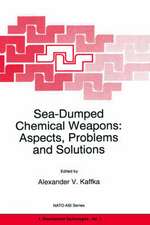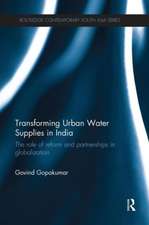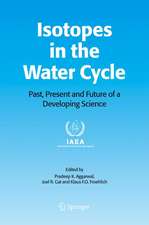Water and Sustainability in Arid Regions: Bridging the Gap Between Physical and Social Sciences
Editat de Graciela Schneier-Madanes, Marie-Francoise Courelen Limba Engleză Paperback – 14 noi 2014
In arid regions, agriculture that is ill-adapted to the environment, accelerated urbanization, poverty, and increasing pollution challenge access to and uses of water. Understanding these issues requires incorporating findings from both the physical and social sciences at different temporal and spatial scales.
The chapters in this book were written by hydrologists, remote sensing specialists, ecologists, historians, economists, political scientists, architects, archaeologists, and other experts who live in and study arid lands. The authors present updates, overviews, and analyses of water challenges these areas have faced and are striving to address, from salinization in the fabled Taklimakan Desert in China to land degradation in the northern Mediterranean to groundwater over-exploitation in the southwestern United States.
The book also examines desertification, remote sensing, qanat systems, architecture, arsenic contamination, and other case studies from Iran, the Maghreb region, Argentina and Chile, and Mexico. From this conceptual mosaic of comparative perspectives and research methods emerges a strong assumption: an interdisciplinary approach that combines physical and social sciences is the first step toward globally and comprehensively addressing water and sustainability."This book is a valuable and welcome contribution to the discussion of water and sustainable development. Through the collection of chapters, the book clearly illustrates the contemporary diversity of approaches to water scarcity and presents pertinent and new research findings that readers generally do not find compiled together. The result is a highly relevant, accessible, and timely resource that is unique in its international and interdisciplinary content. This is a must-read for anyone working on environmental and sustainability issues in arid lands."André Mariotti, University Pierre et Marie Curie, and INSU - CNRS (National Institute for Earth Sciences and Astronomy-National Center for Scientific Research/Centre National de la Recherche Scientifique), France "Anyone who reads this book will find himself or herself contemplating the need to rethink how we approach the issue of water and sustainability in arid lands. Drawing on the expertise of both physical and social scientists, the chapters taken as a whole present global, historic, and current perspectives on water scarcity in a multi-layered way that rarely has been done before." Miguel Solanes, Madrid Water Institute, Spain
| Toate formatele și edițiile | Preț | Express |
|---|---|---|
| Paperback (1) | 1220.45 lei 6-8 săpt. | |
| SPRINGER NETHERLANDS – 14 noi 2014 | 1220.45 lei 6-8 săpt. | |
| Hardback (1) | 1225.16 lei 6-8 săpt. | |
| SPRINGER NETHERLANDS – 26 noi 2009 | 1225.16 lei 6-8 săpt. |
Preț: 1220.45 lei
Preț vechi: 1488.34 lei
-18% Nou
Puncte Express: 1831
Preț estimativ în valută:
233.56€ • 242.94$ • 192.82£
233.56€ • 242.94$ • 192.82£
Carte tipărită la comandă
Livrare economică 14-28 aprilie
Preluare comenzi: 021 569.72.76
Specificații
ISBN-13: 9789400791916
ISBN-10: 9400791917
Pagini: 372
Ilustrații: XXII, 349 p.
Dimensiuni: 155 x 235 x 20 mm
Greutate: 0.52 kg
Ediția:2010
Editura: SPRINGER NETHERLANDS
Colecția Springer
Locul publicării:Dordrecht, Netherlands
ISBN-10: 9400791917
Pagini: 372
Ilustrații: XXII, 349 p.
Dimensiuni: 155 x 235 x 20 mm
Greutate: 0.52 kg
Ediția:2010
Editura: SPRINGER NETHERLANDS
Colecția Springer
Locul publicării:Dordrecht, Netherlands
Public țintă
ResearchCuprins
Contemporary Issues.- Eco-reconstruction in Northwest China.- Remote Sensing Assessment of Salinization Impacts in the Tarim Basin: The Delta Oasis of the Ugan and Kuqa Rivers.- Estimating Net Primary Production in Xinjiang Through Remote Sensing.- The Recent Evolution of the Oasis Environment in the Taklimakan Desert, China.- High Demand in a Land of Water Scarcity: Iran.- Common Scarcity, Diverse Responses in the Maghreb Region.- Changing Water Resources and Food Supply in Arid Zones: Tunisia.- Learning from History.- The Qanat: A Living History in Iran.- Notes from the Turpan Basin: Pioneering Research on the Karez.- An Introduction to the Khettara in Morocco: Two Contrasting Cases.- Digitally Conserving an Endangered Built Heritage in Kashgar, an Oasis City of the Taklimakan.- The Taklimakan Oases: An Environmental Evolution Shown Through Geoarchaeology.- Management for Sustainability.- How the Predominance of Water Resources Informs Management.- Conjunctive Water Management in the US Southwest.- Managing Water Amid Rapid Urbanization: Mexico’s North Borderlands.- Forecasting Streamflows in the San Juan River Basin in Argentina.- Arsenic and Water Quality Challenges in South America.- Evaluating the Restoration of Dryland Ecosystems in the Northern Mediterranean.- Old and New: Changing Paradigms in Arid Lands Water Management.
Textul de pe ultima copertă
International voices fill the pages of Water and Sustainability in Arid Regions, forming an original scientific exploration of current water research and management issues.
In arid regions, agriculture that is ill-adapted to the environment, accelerated urbanization, poverty, and increasing pollution challenge access to and uses of water. Understanding these issues requires incorporating findings from both the physical and social sciences at different temporal and spatial scales.
The chapters in this book were written by hydrologists, remote sensing specialists, ecologists, historians, economists, political scientists, architects, archaeologists, and other experts who live in and study arid lands. The authors present updates, overviews, and analyses of water challenges these areas have faced and are striving to address, from salinization in the fabled Taklimakan Desert in China to land degradation in the northern Mediterranean to groundwater over-exploitation in the southwestern United States.
The book also examines desertification, remote sensing, qanat systems, architecture, arsenic contamination, and other case studies from Iran, the Maghreb region, Argentina and Chile, and Mexico. From this conceptual mosaic of comparative perspectives and research methods emerges a strong assumption: an interdisciplinary approach that combines physical and social sciences is the first step toward globally and comprehensively addressing water and sustainability.
"This book is a valuable and welcome contribution to the discussion of water and sustainable development. Through the collection of chapters, the book clearly illustrates the contemporary diversity of approaches to water scarcity and presents pertinent and new research findings that readers generally do not find compiled together. The result is a highly relevant, accessible, and timely resource that is unique in itsinternational and interdisciplinary content. This is a must-read for anyone working on environmental and sustainability issues in arid lands."
André Mariotti, University Pierre et Marie Curie, and INSU - CNRS (National Institute for Earth Sciences and Astronomy-National Center for Scientific Research/Centre National de la Recherche Scientifique), France
"Anyone who reads this book will find himself or herself contemplating the need to rethink how we approach the issue of water and sustainability in arid lands. Drawing on the expertise of both physical and social scientists, the chapters taken as a whole present global, historic, and current perspectives on water scarcity in a multi-layered way that rarely has been done before."Miguel Solanes, Madrid Water Institute, Spain
In arid regions, agriculture that is ill-adapted to the environment, accelerated urbanization, poverty, and increasing pollution challenge access to and uses of water. Understanding these issues requires incorporating findings from both the physical and social sciences at different temporal and spatial scales.
The chapters in this book were written by hydrologists, remote sensing specialists, ecologists, historians, economists, political scientists, architects, archaeologists, and other experts who live in and study arid lands. The authors present updates, overviews, and analyses of water challenges these areas have faced and are striving to address, from salinization in the fabled Taklimakan Desert in China to land degradation in the northern Mediterranean to groundwater over-exploitation in the southwestern United States.
The book also examines desertification, remote sensing, qanat systems, architecture, arsenic contamination, and other case studies from Iran, the Maghreb region, Argentina and Chile, and Mexico. From this conceptual mosaic of comparative perspectives and research methods emerges a strong assumption: an interdisciplinary approach that combines physical and social sciences is the first step toward globally and comprehensively addressing water and sustainability.
"This book is a valuable and welcome contribution to the discussion of water and sustainable development. Through the collection of chapters, the book clearly illustrates the contemporary diversity of approaches to water scarcity and presents pertinent and new research findings that readers generally do not find compiled together. The result is a highly relevant, accessible, and timely resource that is unique in itsinternational and interdisciplinary content. This is a must-read for anyone working on environmental and sustainability issues in arid lands."
André Mariotti, University Pierre et Marie Curie, and INSU - CNRS (National Institute for Earth Sciences and Astronomy-National Center for Scientific Research/Centre National de la Recherche Scientifique), France
"Anyone who reads this book will find himself or herself contemplating the need to rethink how we approach the issue of water and sustainability in arid lands. Drawing on the expertise of both physical and social scientists, the chapters taken as a whole present global, historic, and current perspectives on water scarcity in a multi-layered way that rarely has been done before."Miguel Solanes, Madrid Water Institute, Spain





















